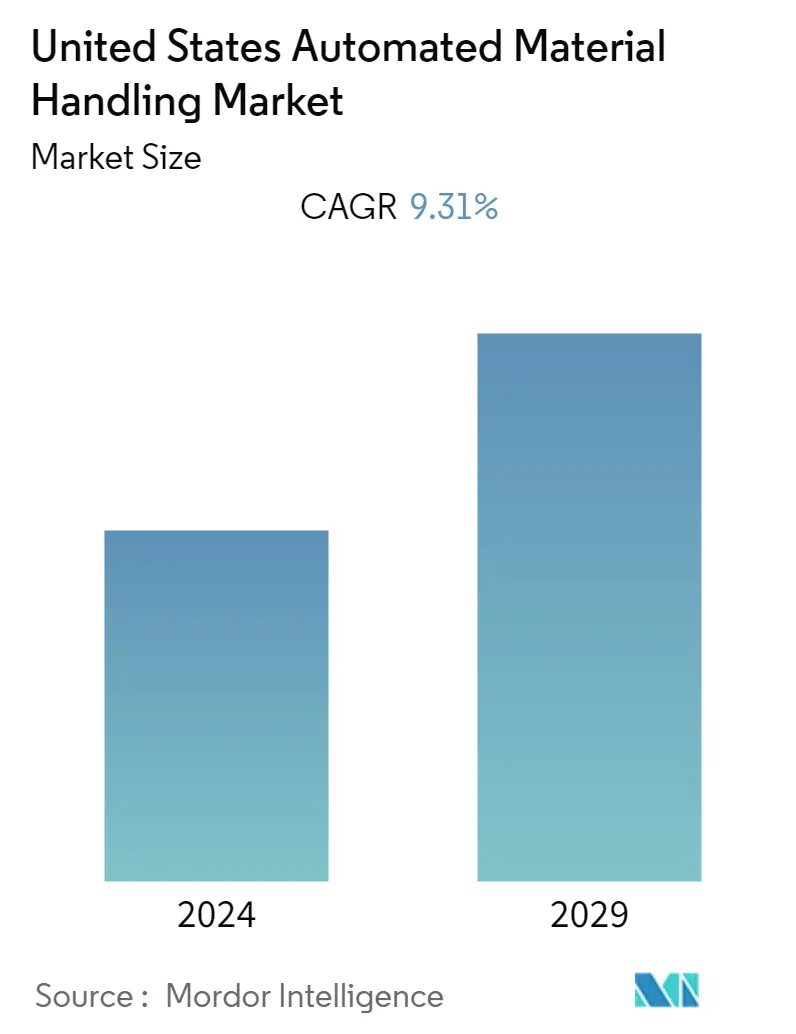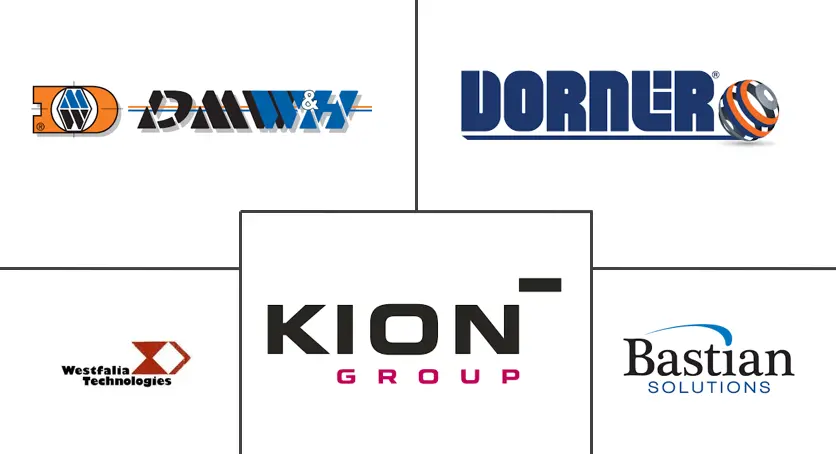
| Study Period | 2019 - 2029 |
| Base Year For Estimation | 2023 |
| Forecast Data Period | 2024 - 2029 |
| Historical Data Period | 2019 - 2022 |
| CAGR | 9.31 % |
| Market Concentration | Medium |
Major Players
*Disclaimer: Major Players sorted in no particular order |
US Automated Material Handling Market Analysis
The United States Automated Material Handling Market was valued at USD 11685.9 million in 2020 and is anticipated to reach USD 19837.93 million by 2026 at a CAGR of 9.31% over the forecast period (2021 - 2026). Moreover, many warehouse sites have been recovering after starting their operations post lockdown in the United States. However, the fluctuations caused in the starting four months of 2020 resulted in order delays and led time across the warehouse robotics supply chain throughout the year. With the spread of the COVID-19 pandemic last year, robots and automation played a critical role in managing the situation. Furthermore, the situation was likely to bring new opportunities to the market.
- The United States is the most advanced economies in the world. The country's manufacturing sector, which is a huge source of demand for the AMH market, hinges on the dominant US economy, accounting for 82% of the region's economic output.
- Moreover, United States is one of the major investors and innovators in the global AMH market owing to the high rate of technological advancements among regional AMH manufacturers, such as automation, AI, and machine learning, and are rapidly driving the industry forward. Increasing demand for advanced automated material handling systems and ever-increasing labor costs with the inconvenience of employing a manual workforce in North America is further driving the United States AMH market.
- Modern manufacturing facilities in the country rely on new technologies and innovations to produce higher quality products at faster speeds, with lower costs. Implementing innovative software and hardware proves the only feasible way to survive in the current competitive market.
- For instance, the FDA Food Safety Modernization Act (FSMA) transforms food companies by shifting the focus from responding to foodborne illness and foreign material contamination to preventing it. As a result, cleanability and sanity have become the biggest priorities of belt manufacturers in the US. Stainless steel also emerged as a popular belt type for food processing in the country. The US post offices also witnessed a 60% energy savings in parcel-handling applications after employing roller conveyors.
- Furthermore, the material handling industry in the country has been significantly disrupted due to the pandemic outbreak. Partial operations within manufacturing facilities and distribution centers have resulted in delayed orders for new AMH systems. During the peak pandemic, warehouses that used manual picking had to halt their operations, thus severely impacting the global supply chain. DHL reported that only 5-10% of the fulfillment centers in the United States are using automated systems already.
- However, vendors strived to enhance their AMH product offerings during the pandemic. For instance, in October 2020, StoecklinLogistics, a supplier of innovative supply chain solutions, introduced a line of dynamic MASTerStacker Cranes (unit load ASRS) that feature high acceleration and moving speeds, improved energy efficiency, and modular construction that delivers vastly improved performance and high levels of availability. The new cranes also have more straightforward and faster wheels and hoists, greater standardization across different cranes and load-carrying capacities, shorter assembly and manufacturing times, lighter construction, and improved accessibility to components for maintenance.
US Automated Material Handling Industry Segmentation
Automated material handling equipment eliminates the need for human interference in a material handling process. The continuous rise in demand for automation with the advent of robotics, wireless technologies, and driverless vehicles in different industries like food and beverages, retail, general manufacturing, pharmaceuticals, and post & parcel has revolutionized the adoption of automated material handling equipment. Moreover, the type of equipment such as AS/RS, AGV, conveyor, palletizer, and sortation systems is considered under the market scope. Further, to arrive at the overall market projections, the study analyzes the impact of COVID-19 and the investment scenario and other macro-economic factors.
| Hardware |
| Software |
| Services |
| Automated Guided Vehicle (AGV) | Automated Forklift |
| Automated Tow/Tractor/Tug | |
| Unit Load | |
| Assembly Line | |
| Special Purpose | |
| Autonomous Mobile Robots (AMR) | |
| Laser Guided Vehicle | |
| Automated Storage and Retrieval System (ASRS) | Fixed Aisle (Stacker Crane + Shuttle System) |
| Carousel (Horizontal Carousel + Vertical Carousel) | |
| Vertical Lift Module | |
| Automated Conveyor | Belt |
| Roller | |
| Pallet | |
| Overhead | |
| Palletizer | Conventional (High Level + Low Level) |
| Robotic | |
| Sortation System |
| Airport |
| Automotive |
| Food and Beverage |
| Retail/Warehousing/ Distribution Centers/Logistic Centers |
| General Manufacturing |
| Pharmaceuticals |
| Post and Parcel |
| Other End-Users |
United States Automated Material Handling Market Size Summary
The United States automated material handling (AMH) market is poised for significant growth, driven by the country's advanced economy and robust manufacturing sector. The demand for AMH systems is bolstered by the need for efficiency and cost-effectiveness in manufacturing and logistics, particularly as labor costs rise and the convenience of manual labor diminishes. The market is characterized by rapid technological advancements, with innovations in automation, artificial intelligence, and machine learning playing a pivotal role in propelling the industry forward. The COVID-19 pandemic has further accelerated the adoption of automation, as businesses sought to mitigate disruptions and enhance operational efficiency. This shift has opened new opportunities for AMH solutions, particularly in sectors like retail and e-commerce, where the demand for automated systems is increasing to meet the growing need for efficient warehouse and distribution operations.
The competitive landscape of the US AMH market is fragmented, with numerous companies employing strategies such as product launches, mergers, acquisitions, and partnerships to maintain their market position. The retail and e-commerce sectors are significant contributors to market growth, with many retailers opting to automate their warehouses to cope with rising demand and high rental costs. The market is also witnessing a shift from traditional automated guided vehicles (AGVs) to more advanced autonomous mobile robots (AMRs), which offer greater flexibility and efficiency. Despite the challenges posed by the pandemic, the market is expected to continue its upward trajectory, supported by ongoing investments in technology and infrastructure. Companies like Amazon and Blackstone Group are leading the charge in expanding automated systems and warehouse space, further driving the market's expansion.
United States Automated Material Handling Market Size - Table of Contents
1. MARKET DYNAMICS
-
1.1 Market Drivers
- 1.1.1 Increasing Manufacturing Complexity and Technology Availability
- 1.1.2 Increasing Demand for Improving Order Accuracy and SKU Proliferation
- 1.1.3 Emergence of Smart City Logistics and Wide Adoption of Robotics in Warehouse Applications
-
1.2 Market Restraints
- 1.2.1 Gap in Supply Chain Skills and Workforce Shortage
- 1.2.2 High initial costs
2. MARKET SEGMENTATION
-
2.1 By Product Type
- 2.1.1 Hardware
- 2.1.2 Software
- 2.1.3 Services
-
2.2 By Equipment Type
- 2.2.1 Automated Guided Vehicle (AGV)
- 2.2.1.1 Automated Forklift
- 2.2.1.2 Automated Tow/Tractor/Tug
- 2.2.1.3 Unit Load
- 2.2.1.4 Assembly Line
- 2.2.1.5 Special Purpose
- 2.2.2 Autonomous Mobile Robots (AMR)
- 2.2.3 Laser Guided Vehicle
- 2.2.4 Automated Storage and Retrieval System (ASRS)
- 2.2.4.1 Fixed Aisle (Stacker Crane + Shuttle System)
- 2.2.4.2 Carousel (Horizontal Carousel + Vertical Carousel)
- 2.2.4.3 Vertical Lift Module
- 2.2.5 Automated Conveyor
- 2.2.5.1 Belt
- 2.2.5.2 Roller
- 2.2.5.3 Pallet
- 2.2.5.4 Overhead
- 2.2.6 Palletizer
- 2.2.6.1 Conventional (High Level + Low Level)
- 2.2.6.2 Robotic
- 2.2.7 Sortation System
-
2.3 By End-user Vertical
- 2.3.1 Airport
- 2.3.2 Automotive
- 2.3.3 Food and Beverage
- 2.3.4 Retail/Warehousing/ Distribution Centers/Logistic Centers
- 2.3.5 General Manufacturing
- 2.3.6 Pharmaceuticals
- 2.3.7 Post and Parcel
- 2.3.8 Other End-Users
US Automated Material Handling Market Research FAQs
What is the current United States Automated Material Handling Market size?
The United States Automated Material Handling Market is projected to register a CAGR of 9.31% during the forecast period (2025-2030)
Who are the key players in United States Automated Material Handling Market?
Kion Group AG, Bastian Solutions Inc., DMW&H, Westfalia Technologies Inc. and Dorner Manufacturing Corporation are the major companies operating in the United States Automated Material Handling Market.


